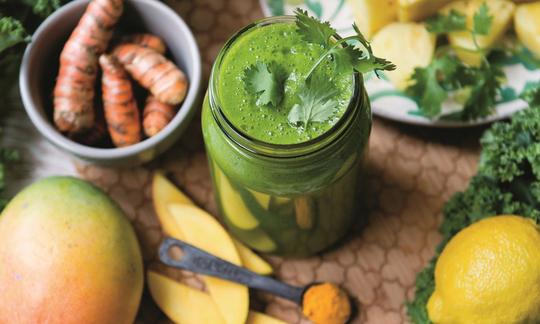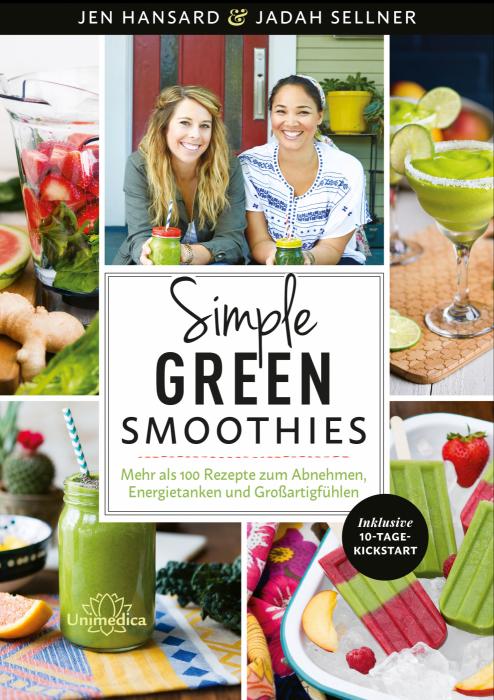Tropical Turmeric Cleanser Green Smoothie
raw-vegan
Ingredients (for servings, )
| 13 oz | Pineapple, raw (organic?) |
| 3 ¼ oz | Kale, raw (spring cabbage, organic?) |
| ¼ bunch | Coriander leaves, raw (0.18 oz) |
| 500 ml | Coconut water, raw? (Coconut water, coconut juice, organic?) (18 oz) |
| 5 ½ oz | Mangos, raw (organic?) |
| ½ | Lemons, raw (limes, organic?) (1.0 oz) |
| ½ tsp | Turmeric (saffron root), ground, raw (organic?) (0.05 oz) |
Equipment
- blender or hand-held blender / immersion blender
- refrigerator
- citrus juicer (lemon squeezer)
- freezer
Type of preparation
- chop or grind
- food preparation without heating
- blend
- squeeze
- put on ice
- cool
- peel
Preparation
Preparation – optional
Remove the skin from the pineapple (or mango) and cut the fruit into small chunks. Freeze the fruit until you are ready to prepare the smoothie.This step is optional, so we have not included the time required for this step in the total preparation time for the recipe. You can also prepare the fruit the day before and freeze it overnight.
For the smoothie
Wash and remove the stems from the kale and then blend with the cilantro and coconut water until the mixture is smooth.The original recipe lists 70 g of kale without stems for two servings. We have adjusted the quantity of the other ingredients to ensure that you will have enough kale.
If you have not prepared the pineapple (mango) in advance, remove the peel from the fruit and cut the fruit into chunks. Squeeze the juice from the lemon and add it to the smoothie along with the fruit chunks and the turmeric.
Blend all of the ingredients until smooth. Serve this delicious tropical smoothie in an attractive glass.
You can also chill the smoothie before serving if you didn’t use frozen fruit. However, it tastes best when served immediately.
|
Nutritional Information per person
Convert per 100g
|
2000 kcal | |
|---|---|---|
| Energy | 217 kcal | 10.9% |
| Fat/Lipids | 1.5 g | 2.2% |
| Saturated Fats | 0.59 g | 3.0% |
| Carbohydrates (inc.dietary fiber) | 51 g | 19.1% |
| Sugars | 37 g | 41.1% |
| Fiber | 8.9 g | 35.7% |
| Protein/Albumin | 5.7 g | 11.4% |
| Cooking Salt (Na:287.8 mg) | 731 mg | 30.5% |
| Essential micronutrients with the highest proportions | per person | 2000 kcal | |
|---|---|---|---|
| Vit | Vitamin K | 329 µg | 439.0% |
| Vit | Vitamin C (ascorbic acid) | 187 mg | 233.0% |
| Min | Manganese, Mn | 2.6 mg | 131.0% |
| Min | Copper, Cu | 1.1 mg | 109.0% |
| Vit | Vitamin B9, B11 (Folate, as the active form of folic acid) | 141 µg | 70.0% |
| Elem | Potassium, K | 1'237 mg | 62.0% |
| Vit | Vitamin B6 (pyridoxine) | 0.52 mg | 37.0% |
| Sodium, Na | 288 mg | 36.0% | |
| Vit | Vitamin A, as RAE | 280 µg | 35.0% |
| Elem | Magnesium, Mg | 118 mg | 32.0% |
Detailed Nutritional Information per Person for this Recipe
The majority of the nutritional information comes from the USDA (US Department of Agriculture). This means that the information for natural products is often incomplete or only given within broader categories, whereas in most cases products made from these have more complete information displayed.
If we take flaxseed, for example, the important essential amino acid ALA (omega-3) is only included in an overarching category whereas for flaxseed oil ALA is listed specifically. In time, we will be able to change this, but it will require a lot of work. An “i” appears behind ingredients that have been adjusted and an explanation appears when you hover over this symbol.
For Erb Muesli, the original calculations resulted in 48 % of the daily requirement of ALA — but with the correction, we see that the muesli actually covers >100 % of the necessary recommendation for the omega-3 fatty acid ALA. Our goal is to eventually be able to compare the nutritional value of our recipes with those that are used in conventional western lifestyles.
| Essential fatty acids | per person | 2000 kcal |
|---|---|---|
| Alpha-Linolenic acid; ALA; 18:3 omega-3 | 0.16 g | 8.0% |
| Linoleic acid; LA; 18:2 omega-6 | 0.14 g | 1.0% |
| Essential amino acids | per person | 2000 kcal |
|---|---|---|
| Tryptophan (Trp, W) | 0.04 g | 17.0% |
| Threonine (Thr, T, irreversibly transaminated) | 0.13 g | 14.0% |
| Valin (Val, V) | 0.19 g | 12.0% |
| Isoleucine (Ile, I) | 0.13 g | 11.0% |
| Lysine (Lys, K, irreversibly transaminated) | 0.18 g | 10.0% |
| Phenylalanine (Phe, F) | 0.16 g | 10.0% |
| Leucine (Leu, L) | 0.22 g | 9.0% |
| Methionine (Met, M) | 0.06 g | 7.0% |
| Vitamins | per person | 2000 kcal |
|---|---|---|
| Vitamin K | 329 µg | 439.0% |
| Vitamin C (ascorbic acid) | 187 mg | 233.0% |
| Vitamin B9, B11 (Folate, as the active form of folic acid) | 141 µg | 70.0% |
| Vitamin B6 (pyridoxine) | 0.52 mg | 37.0% |
| Vitamin A, as RAE | 280 µg | 35.0% |
| Vitamin B1 (Thiamine) | 0.30 mg | 28.0% |
| Vitamin B2 (Riboflavin) | 0.30 mg | 22.0% |
| Vitamin B3 (Niacin) | 2.2 mg | 13.0% |
| Vitamin E, as a-TEs | 1.5 mg | 13.0% |
| Vitamin B5 (Pantothenic acid) | 0.75 mg | 12.0% |
| Vitamin B7 (Biotin, ex vitamin H) | 0.07 µg | < 0.1% |
| Essential macroelements (macronutrients) | per person | 2000 kcal |
|---|---|---|
| Potassium, K | 1'237 mg | 62.0% |
| Sodium, Na | 288 mg | 36.0% |
| Magnesium, Mg | 118 mg | 32.0% |
| Calcium, Ca | 168 mg | 21.0% |
| Phosphorus, P | 124 mg | 18.0% |
| Essential trace elements (micronutrients) | per person | 2000 kcal |
|---|---|---|
| Manganese, Mn | 2.6 mg | 131.0% |
| Copper, Cu | 1.1 mg | 109.0% |
| Iron, Fe | 2.6 mg | 19.0% |
| Zinc, Zn | 0.86 mg | 9.0% |
| Selenium, Se | 3.7 µg | 7.0% |
| Iod, I (Jod, J) | 0.23 µg | < 0.1% |
Narayana Verlag GmbH /Unimedica Verlag , Jen Hansard, Jadah Sellner
Raw recipes 111 (3), Cooked recipes 9
Additional photos (6)
In "Simple Green Smoothies," the authors' formula for better health, more concentration, and energy is: drink a green smoothie every day.
Since this book is written in German, a description is omitted here. If you are interested, please switch to German in the menu.
This delicious Tropical Turmeric Cleanser Green Smoothie made with coconut water base provides loads of vitamin C along with an antioxidant boost from kale.
Chilled smoothie: The authors recommend using frozen pineapple (or mango) for a nice cold smoothie. We did not include freezing time in the total preparation time since we consider this to be an optional step. You can also freeze the fruit overnight or chill the smoothie after you prepare it.
Turmeric: Turmeric is a member of the ginger family and is native to South Asia. While fresh turmeric has a somewhat bitter and slightly spicy flavor, dried turmeric is milder with just a touch of bitterness. Current studies are researching possible cancer-inhibiting and anti-inflammatory effects of curcumin, the main constituent in turmeric. It should also be noted that the bioavailability (the extent to which a nutrient or medication can be used by the body) of curcumin is low. This means that researchers will need to find solutions for ways to administer possible therapeutic doses. In addition, older studies may have had false positive results because of the evaluation methods used or the nonspecific interactions of the active ingredient with biological targets.
Cilantro: There is a wide range of opinions regarding the flavor of cilantro. Some people react to its intensive, slightly soapy aroma with aversion ranging to nausea. According to Swiss statistics, 15 % of people with allergies are affected. You can just omit this ingredient in these cases. There is no alternative with a similar flavor. Flat-leaf parsley may look like cilantro but has a completely different flavor. Nevertheless, it is often used as a substitute.
Lemon juice: Lemon juice adds flavor and is also used to prevent discoloration in certain foods (e.g., avocados, apples, and bananas). Enzymatic browning is a chemical reaction that occurs when the enzyme polyphenol oxidase inside of the fruit or vegetable comes into contact with oxygen. The citric acid in lemon juice reduces the pH and creates a barrier between the polyphenol oxidase and the oxygen. Until the lemon juice has evaporated or been completely absorbed, the oxygen reacts with the ascorbic acid, preventing the fruit from turning brown.
Citric acid, or vitamin C, is important as an intermediate in the citric acid cycle of our metabolism. Even though there are many culinary uses for lemon juice, you should be aware that the acids in it will attack your tooth enamel. Tooth enamel will begin to demineralize when citric acid is present in higher concentrations (pH values of less than 5.5). To protect the enamel on your teeth, don’t brush your teeth immediately after eating or drinking anything containing citrus. The act of brushing will wear away the tooth enamel that has been weakened by the acid. Lemon juice also has many other uses, including as an all-around cleaner, air freshener, water softener, and rust remover.
Peeling mangoes: There are many ways to peel a mango. One of the easiest is the “porcupine,” method which results in nice cubes. All you will need is a knife and a cutting board. First cut along each side of the pit, separating the flesh from the pit. With the skin side down, score the flesh into a grid pattern, cutting down to the skin but not through it. Pick up the mango half and with two hands push up on the skin underneath to invert the mango and then slide the knife along the skin to release the cubes or remove them by hand.
Lemon juice: If you don’t have fresh lemons on hand, you can use bottled lemon juice. On average, a lemon is made up of slightly more than one-third lemon juice; for example, a 120 g lemon contains 3–6 tbsp lemon juice. For this smoothie (2 servings), use about 1.5–2 tbsp lemon juice and add more if desired.




